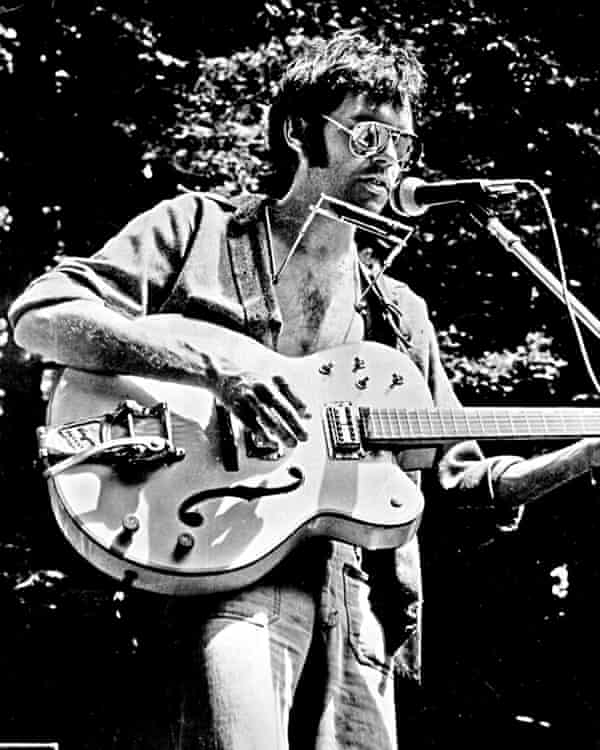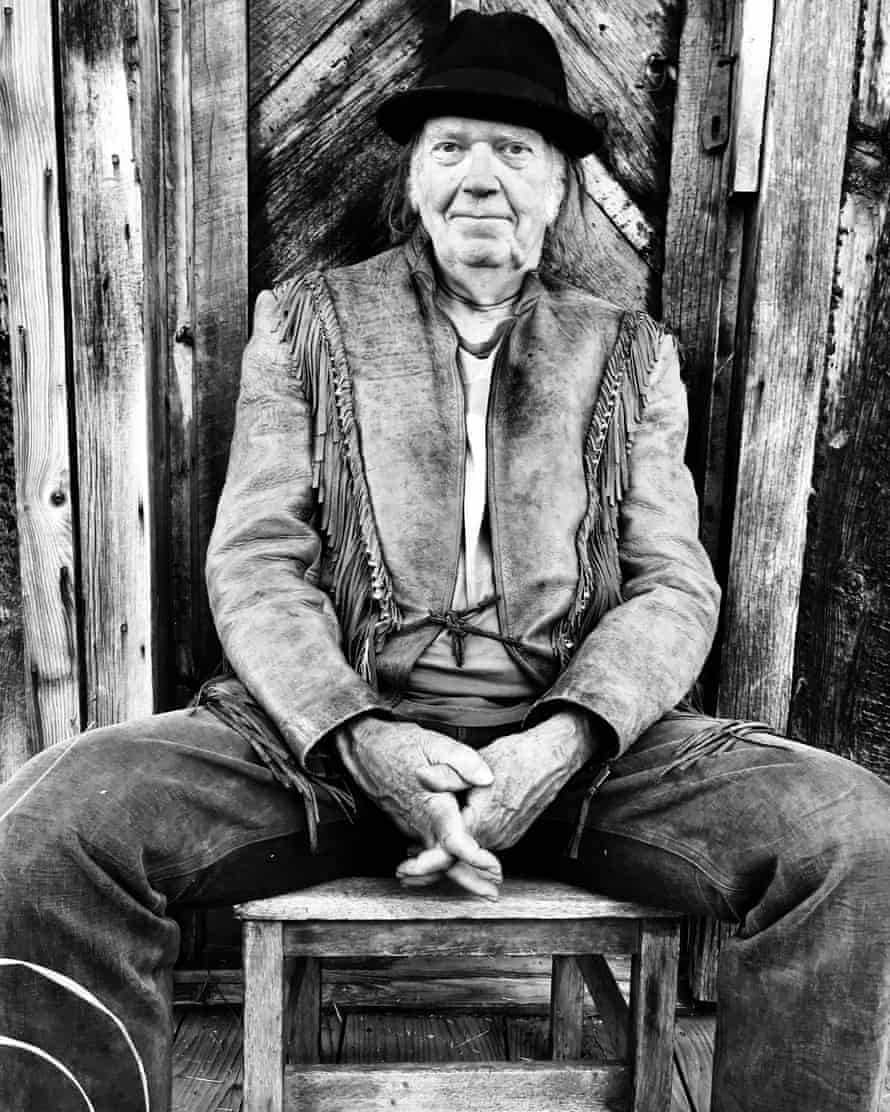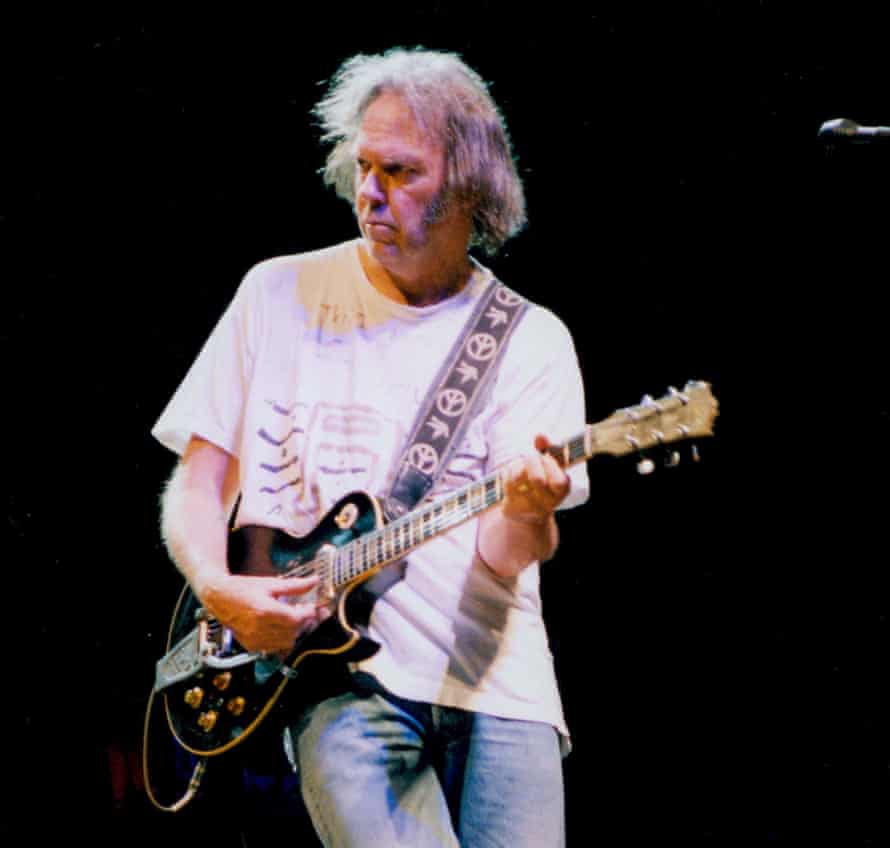Joe Bethancourt That Great Big Way Out There Cover Art Cd
45. Landing on Water (1986)
If other 1970s greats, including Don Henley, were having 80s hits with modern, synth-heavy records then why shouldn't Neil Young give it a go? A question to which the obvious answer is: because it might sound like Landing on Water, on which perfectly good songs – non least Hippie Dream's devastating portrait of David Crosby in his coked-out ruin – were knackered by sterile, unsympathetic production.
44. Everybody's Rockin' (1983)
As a monumental middle-finger to a record characterization that had demanded a "rock" album from Young, the rockabilly and 50s R&B of Everybody's Rockin' is pretty impressive. As a listening feel, non then much. The digital product is horrible; the cover of Jimmy Reed'south Bright Lights Big City abysmal.
43. Old Ways (1985)
It has its moments, My Male child and Are There Any More Real Cowboys? among them, but Young's 80s country record – produced once more, information technology seemed, mainly to annoy his and so-label, Geffen – is overproduced, syrupy and cliched to the signal of sounding patronising. His subsequent courting of the conservative Nashville market past making reactionary statements in interviews is best overlooked.
42. Are Y'all Passionate? (2002)

This collaboration with Booker T and the MGs, which attracted much attending for the bellicose, post-nine/xi-themed Let'due south Roll, is otherwise forgettable: competent, aimless mid-tempo songs; low on thrills. Relief arrives when Crazy Horse lumber gracelessly into view on Goin' Home.
41. Peace Trail (2016)
You lot cannot fault Young's recent work ethic, or his political commitment, only Peace Trail – his second anthology of 2016, partly inspired by the environmental protests at Standing Stone reservation – was a mess: sketchy songwriting, half-baked musical ideas including a flare-up of Auto-Tuned vocals, platitudinous lyrics. Skilful title track, though.
xl. Life (1987)
Later hobbling Landing on Water with a cack-handed application of synths and drum machines, Immature proceeded to hobble an anthology with his quondam muckers Crazy Equus caballus in exactly the same way. Information technology's infuriating equally the songs were frequently great, equally evidenced by Prisoners of Rock and Roll, a virtual manifesto for Crazy Horse's primitive musical approach: "We don't wanna be good."
39. Fork in the Road (2009)
"I'k a big stone star, my sales accept tanked / But I still got you – thanks," offered Young on the championship track. He's nothing if not honest, merely his sales might have held up better had his subsequently albums not sounded increasingly dashed-off, with more than thought put into their letters – here about pollution and the ongoing fiscal crunch – than the music.
38. Broken Arrow (1996)
In that location is a pervasive theory that Young'south music has suffered since the death of his long-term producer, David Briggs, the one human who seemed capable of reining him in and calling out his less inspired ideas. Certainly the get-go album he fabricated after Briggs'due south expiry felt sprawling and directionless: long Crazy Horse jams aslope bootleg-quality live tracks.
37. Paradox (2018)
Darryl Hannah's breathless film about Immature and his latest young collaborators, Promise of the Real, is an endurance test to rival 1972's similarly aimless documentary Journeying Through the Past, merely the soundtrack – a patchwork of instrumental passages, outtakes and live recordings – is quite immersive and enjoyable as it drifts along, although clearly but diehard Young nuts need apply.
36. Colorado (2019)
The latest in a succession of middling albums with Crazy Horse, Colorado features some incendiary performances in the band's patent ham-fisted way – there's a moment midway through She Showed Me Honey where drummer Ralph Molina appears to stop playing by mistake – but information technology also features some painfully on-the-nose political lyrics, and not much in the way of decent tunes.
35. Storytone (2014)

Indecision plagued Storytone, which Immature released in 3 versions: one orchestrated, i stripped dorsum, one with a flake of both. Maybe he realised that the album'south initial Neil Young-equally-crooner concept didn't quite work, veering every bit information technology did between charming (the big band-fuelled I Want to Drive My Machine) and schlocky (Tumbleweed).
34. Prairie Current of air (2005)
The least appealing of Young'due south albums in the Harvest vein, Prairie Wind is withal ane of Immature's stronger latter-day albums. The autumnal, cogitating mood of He Was the Male monarch and This Former Guitar were presumably influenced past the expiry of his father and Young's own brush with mortality after a brain aneurysm.
33. Silver & Gold (2000)
Another album in the land-rock vein of Harvest. The highlights are loftier – the heart-searching closer Without Rings is specially fine – but there is a lot of filler, and the rose-tinted nostalgia of Immature'due south paean to his erstwhile band, Buffalo Springfield Again, is particularly runny.
32. Greendale (2003)
Hailed by some as a return to form – which but meant an improvement on its lacklustre predecessor, Are You Passionate? – Greendale was Immature's rock opera, a grandiose title that seemed antithetical to its rough, bluesy sound. The songwriting is too uneven to sustain involvement: Be the Rain and Bandit are peachy; Grandpa's Interview interminable.
31. Arc (1991)
Information technology was Sonic Youth's Thurston Moore who suggested Young release a live album entirely comprised of the feedback-laden intros and outros of his live performances. Mixed in the studio into one 35-minute track, information technology is not quite as confrontational a statement as Lou Reed'southward Metal Machine Music, but information technology's worth hearing at least once.
xxx. The Monsanto Years (2015)
Young's latest backing band, Hope of the Real, audio fiery here, and Young himself is audibly livid, just The Monsanto Years was another album that felt rushed to the signal that bodily writing had been overlooked. The lyrics – raining burn down on GMOs – frequently feel more similar ranting blogposts set to music than songs.
29. Trans (1982)
Inspired by his quadriplegic son Ben, an electronic Neil Young concept album with vocodered vocals was an incredibly assuming motion, so much then that Young padded it out with more straightforward material. The finish result was a curious mess; the loveliness of Transformer Man was fully revealed only when Young played information technology acoustically on 1993'southward MTV Unplugged.
28. Hawks & Doves (1980)
Distracted by family unit strife, Young's follow-up to the classic Rust Never Sleeps was a ragged collection of thrown-together country tunes and sundry offcuts. Hawks & Doves is wildly uneven, its championship runway flatly awful, but the good $.25 – the sinister Captain Kennedy, the beautiful Lost in Infinite, The Sometime Homestead's lengthy allegory for his own career – are fantastic.
27. Mirror Ball (1995)
Conspicuously proud of his "godfather of grunge" tag – Crazy Horse's combination of looseness and intensity was a primal influence on the sound – Mirror Brawl saw Young collaborating with Pearl Jam. The results were solid, just never explosive or edgy enough to stop y'all wishing he'd called to work with his former tourmates Sonic Youth, who might have pushed him harder.
26. Chrome Dreams Ii (2007)
Classic Neil: xxx years after declining to release an album chosen Chrome Dreams, he puts out a follow-up. Chrome Dreams 2 hinges on 1 track, the astonishing eighteen-minute Ordinary People. Recorded in 1987, information technology casts well-nigh of the anthology's newer material in an unforgiving light, but the frazzled, ultra-distorted Muddy Sometime Homo holds its own.

25. Americana (2012)
An album largely comprised of folksongs dramatically reassembled – Clementine and Oh Susanna amidst them – Americana is sporadically peachy, occasionally sloppy and sometimes genuinely surprising. Improbably enough, it concludes with Crazy Equus caballus setting almost God Save the Queen, every bit in the Uk national anthem, non the Sex Pistols song.
24. Neil Young (1968)
"Overdub city," protested Young of his solo debut, and he had a point. It is packed with fantastic songs that Immature would repeatedly render to live – The Loner, Here Nosotros Are in the Years, The Old Laughing Lady – but frequently groans nether the weight of Jack Nitzsche'southward elaborate arrangements. From this point on, Young would prize simplicity and spontaneity.
23. Psychedelic Pill (2012)
Crazy Horse fabricated their proper noun playing extended jams, an approach Psychedelic Pill took to the farthermost: the opener here, Driftin' Back, goes on for the best part of half an 60 minutes. Whether it warrants that length is another question, although Ramada Inn, which clocks in at a mere 16 minutes, is terrific.
22. Dead Homo (1995)
Young's offset movie soundtrack, 1972's Journey Through the By, was a hodgepodge of live recordings and outtakes that succeeded in horrifying fans who thought it was the follow-upwardly to Harvest. Performed live to a crude cut of Jim Jarmusch's surreal western Expressionless Man, it is something else: a lengthy, stark, occasionally violent guitar instrumental.
21. American Stars 'North Confined (1977)
The weakest of Immature'southward 1970s studio albums, American Stars 'N Bars matched tracks taken from the and then-unreleased Homegrown with lo-fi home recordings (the oddly creepy Will to Honey), leaden country-stone and ane undisputed Crazy Equus caballus archetype: Similar a Hurricane (although there are ameliorate live versions out there).
xx. A Letter of the alphabet Home (2014)
Information technology sounds like a novelty – Young recording cover versions in a 1947 vinyl recording booth owned by Jack White – only A Letter of the alphabet Habitation works, leaping from songs Young would have played equally a coffeehouse folk vocaliser, such as Bert Jansch'south Needle of Decease, to a haunting version of Bruce Springsteen'southward My Hometown.
19. Living With War (2006)
Swiftly recorded and released, backed past a 100-voice choir, the anti-Iraq war tirade Living With State of war finds Young sounding energised past the urgency of his undertaking and, ane suspects, by the furore he must have known it would cause. A subsequent Crosby Stills Nash & Young tour heavy on this cloth was greeted by boos and walkouts from their more conservative fans.
eighteen. Re-ac-tor (1981)
A Crazy Horse anthology that'south grinding, night and repetitious (deliberately so; information technology'south influenced by a gruelling programme of handling undergone by Immature'due south son), Re-air-conditioning-tor is difficult piece of work, occasionally bromidic and sometimes magnificent, every bit on the ferocious din of Surfer Joe and Moe the Sleaze and the terminal Shots.
17. Harvest (1972)
That Harvest's huge commercial success sparked a bout of wilful, even contrarian behaviour in Young wasn't so inexplicable: he presumably knew his biggest album was nowhere near his best. The songs veer from fantastic (the title rails; Words) to forgettable, while the arrangements are slick but sometimes overblown, every bit on A Man Needs a Maid.
xvi. This Note'southward for You (1988)
By far the virtually successful of Immature's 80s genre experiments, and a creative rebirth of sorts, Young's bluesy R&B album is all-time known for its title track, an evisceration of 80s rock'due south growing penchant for corporate sponsorship, but its best moments are subtle and understated: the atmospheric Twilight, the minor-hours melancholy of Coupe De Ville.
15. Hitchhiker (1976)
The sound of Immature alone in the studio, "turning on the tap" every bit David Briggs put information technology, and letting new songs cascade out (almost all of which ended upward being re-recorded elsewhere). The fact that Young is audibly, heroically stoned throughout only adds to the album's intimate charm.
xiv. Le Noise (2010)
Produced past Daniel Lanois, this is Young'south best album of the 21st century, and information technology took him somewhere new. Lanois added the occasional disorientating tape loop while Young accompanies himself on distorted electric guitar, which he is clearly playing at ear-splitting volume. Bringing this freshness of arroyo to a solo singer-songwriter album resulted in some potent fabric.
13. Harvest Moon (1992)
Harvest Moon is better than the classic album its title referenced, and whose backing musicians it reassembled. The sound fits the songs, which are wistful and streaked with nostalgia. The title track, its riff nicked from the Everly Brothers' Walk Right Back, is a genuinely beautiful hymn to marriage and enduring beloved.
12. Ragged Glory (1991)
Crazy Horse at their nigh gleefully primitive – Immature manifestly recorded his vocals standing in a pile of horse manure – rampaging through garage-rock standards (the Premiers' Farmer John), riotous jams (Dear and Just Love, Mansion on the Hill) and paeans to their own limitations (F!#*in' Upward). A nail from starting time to stop.
xi. Homegrown (1975)
"Sometimes life hurts," wrote Immature in explanation of Homegrown'due south belated 2020 release, 45 years afterwards he recorded information technology in the wake of his split from the actor Carrie Snodgrass. It's certainly downcast, its tone set by the opener Separate Ways, but it is also Young at the peak of his powers, writing fragile, beautiful songs.
10. Comes a Fourth dimension (1978)
The gentle country-stone anthology his record visitor doubtless wished he had released as a follow-up to Harvest, Comes a Fourth dimension is far improve than its spiritual predecessor. Information technology is rougher round the edges – Crazy Horse show upwardly on the wonderful Lotta Beloved and Look Out for My Love – and home to a caryatid of Young classics, the title rails amidst them.
9. Freedom (1989)
After a confused 1980s, Young'south stunning return to full, raging power was perfectly timed, chiming with the nascent grunge move he helped inspire. The widely misinterpreted Rockin' in the Free World was the striking, but Liberty is packed with killer tracks, from the lengthy, horn-backed Offense in the Metropolis (Sixty to Zero) to a ferocious, feedback-strafed embrace of On Broadway.
8. Sleeps With Angels (1994)
Kurt Cobain's suicide notation quoted a Immature lyric, much to its author's horror; the championship track of Sleeps With Angels was his distressed response. Elsewhere, this is every bit bleakly compelling and creepy as his mid-70s work, with Crazy Horse on surprisingly muted form. Piece of Crap, meanwhile, introduces Young the cranky middle-aged refusenik, a function he would oftentimes inhabit.
seven. Time Fades Away (1973)
Only Neil Immature would follow up his commercial breakthrough with a chaotic audio-verité souvenir of a disastrous tour. But Time Fades Away isn't simply a screw-you lot gesture, information technology's utterly compelling. The songs – Last Dance's churning, hippy-baiting din; fragile piano ballad The Bridge; and the autobiographical Don't Be Denied – are incredible, potentiated by the ragged performances.
half-dozen. Zuma (1975)
Lighter in tone than the "ditch trilogy" (Time Fades Away, Tonight'south the Night and On the Beach) that preceded information technology, Zuma reunited Young with a revitalised Crazy Horse, sparking Barstool Blues's glorious evocation of a drunk mind meandering and the brooding, regal historical epic Cortez the Killer. And its lambent closer Through My Sails is the last truly cracking vocal that Crosby Stills Nash & Immature released.

5. After the Gold Rush (1970)
Afterward The Gilt Rush feels like Young'due south morning-after-the-60s anthology, simply unlike the consoling tone of Simon & Garfunkel'southward Bridge Over Troubled H2o, it is gaunt, troubled and affecting. Amid the human relationship woes, there is ecological disaster, racism and Don't Let It Bring You lot Down, which, Immature noted, was "guaranteed to bring yous downwardly".
4. On the Beach (1974)
Despairing and disconsolate, but set to beautiful music: the shimmering electric piano of See the Sky Well-nigh to Rain, the epic acoustic closer Ambulance Blues ("You're all just pissing in the wind," it concludes), the title track's stoned, misty take on rock. For contrast, there is Revolution Blues, a ferocious, unsparing portrait of Young's old acquaintance Charles Manson.
3. This night's the Night (1975)
Young's tequila-sodden, no-filter response to the deaths of Crazy Horse guitarist Danny Whitten and their roadie Bruce Berry is harrowing, extraordinarily powerful listening, the drunken raucousness of the performances matching the raw emotion of the songs. The point when Young's voice cracks during Mellow My Mind is perhaps the most starkly potent in his catalogue.
2. Everybody Knows This Is Nowhere (1969)
Young'south debut with Crazy Horse is an incredible album: the sheer dominance of its songs and sound; the killer riff of Cinnamon Daughter; the style the playing on the extended jams Downwards By the River and Cowgirl in the Sand embodies their lyrical angst, keeping the listener utterly gripped even as they tip the 10-minute mark.
1. Rust Never Sleeps (1979)
The line between Young'southward live and studio albums has ever been flexible. Rust Never Sleeps was recorded on phase in 1978, so overdubbed. In truth, most of his 70s albums could conceivably be called his best – he kept up a remarkably high standard – but Rust Never Sleeps offers a perfect summary of everything that makes him great, its quality possibly spurred by the punk movement he references on Hey Hey, My My (Into the Black) and, more elliptically, on Thrasher. Side one'south sequence of acoustic songs is breathtaking, and Crazy Horse rage in thunderous style on side two, habitation to Powderfinger's heartbreaking saga of violence, death and familial bonds – arguably his greatest vocal.
Source: https://www.theguardian.com/music/2020/nov/05/neil-young-every-album-ranked
0 Response to "Joe Bethancourt That Great Big Way Out There Cover Art Cd"
Enviar um comentário